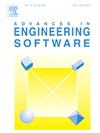Efficient seismic response modeling for train-bridge systems: A time series mixer approach
IF 5.7
2区 工程技术
Q2 COMPUTER SCIENCE, INTERDISCIPLINARY APPLICATIONS
引用次数: 0
Abstract
This paper introduces an innovative surrogate modeling approach for predicting seismic responses in train-bridge coupled (TBC) systems, utilizing the Time Series Mixer (TSMixer) neural network. The model features a multi-layered architecture with sliding time windows, ensuring continuous, real-time analysis. We refined key performance metrics to address limitations in traditional response evaluation, particularly in handling phase discrepancies. The TSMixer model demonstrates high accuracy across a variety of seismic waves and system parameters, making it a valuable tool for rapid prediction in urban seismic scenarios. By offering swift and precise assessments, this approach has significant implications for improving the design efficiency of high-speed rail systems under seismic conditions. This research advances the field by introducing a robust method capable of capturing the nonlinear dynamics of TBC systems, fulfilling modern engineering demands for speed and precision in seismic analysis.
列车-桥梁系统的有效地震反应建模:一种时间序列混合方法
本文介绍了一种利用时间序列混频器(TSMixer)神经网络预测列车-桥梁耦合(TBC)系统地震反应的创新代理建模方法。该模型具有多层结构和滑动时间窗口,确保了连续、实时的分析。我们改进了关键性能指标,以解决传统响应评估中的局限性,特别是在处理阶段差异方面。TSMixer模型在各种地震波和系统参数中都具有很高的精度,使其成为城市地震场景快速预测的宝贵工具。通过提供快速和精确的评估,该方法对提高高速铁路系统在地震条件下的设计效率具有重要意义。本研究通过引入一种能够捕获TBC系统非线性动力学的鲁棒方法推进了该领域的发展,满足了现代工程对地震分析速度和精度的要求。
本文章由计算机程序翻译,如有差异,请以英文原文为准。
求助全文
约1分钟内获得全文
求助全文
来源期刊

Advances in Engineering Software
工程技术-计算机:跨学科应用
CiteScore
7.70
自引率
4.20%
发文量
169
审稿时长
37 days
期刊介绍:
The objective of this journal is to communicate recent and projected advances in computer-based engineering techniques. The fields covered include mechanical, aerospace, civil and environmental engineering, with an emphasis on research and development leading to practical problem-solving.
The scope of the journal includes:
• Innovative computational strategies and numerical algorithms for large-scale engineering problems
• Analysis and simulation techniques and systems
• Model and mesh generation
• Control of the accuracy, stability and efficiency of computational process
• Exploitation of new computing environments (eg distributed hetergeneous and collaborative computing)
• Advanced visualization techniques, virtual environments and prototyping
• Applications of AI, knowledge-based systems, computational intelligence, including fuzzy logic, neural networks and evolutionary computations
• Application of object-oriented technology to engineering problems
• Intelligent human computer interfaces
• Design automation, multidisciplinary design and optimization
• CAD, CAE and integrated process and product development systems
• Quality and reliability.
 求助内容:
求助内容: 应助结果提醒方式:
应助结果提醒方式:


